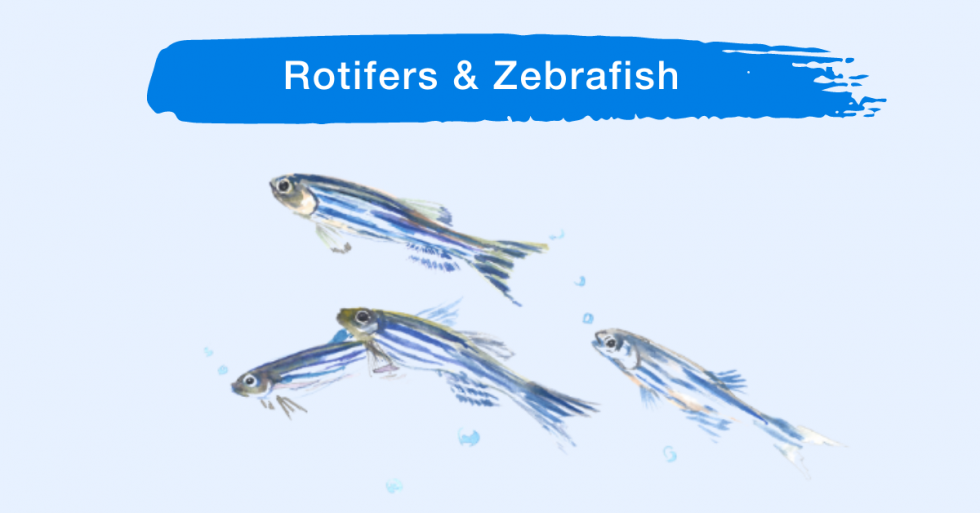
The Utilization of Rotifers in Zebrafish Facilities
Feeding on Live Prey
The use of live prey for larval fish is a common methodology employed by various laboratories, research institutions, and fish facilities. Rotifers and Artemia are two popular live feeds that are commonly utilized in zebrafish labs. Rotifers (in this case, Brachionus plicatilis) have been proven to be an effective option for first-feeding larvae – yielding consistently high growth rates, survival, and overall health. Rotifers are a go-to option (and are considered the best option) because they are highly nutritious/digestible with the right amino acid profile, are slow swimmers and encourage the natural instincts of zebrafish, and are very easy to culture serving as an ideal early feeding option. Furthermore, rotifers can also be enriched in various ways to heighten their nutritional value, depending on the type of microalgae or encirclement formula you provide them with. Once the larvae get of age, they can then be transitioned onto an appropriate dry formulated diet.

Rotifer Culturing Systems / Cones
Running an entire zebrafish facility (including both husbandry and research tasks) can be intensive and expensive, therefore streamlining and optimizing components of your fish room such as your live feed production operations can be advantageous in your overall, long-term zebrafish operations. Fortunately, setting up and maintaining a rotifer system is typically pretty straightforward, flexible, and can be constructed as small or as large scale as needed. This ranges from benchtop systems to larger operations, where an entire room can be dedicated to live feed production. It’s possible to build and make your own system or alternatively you can purchase a ready-to-use system that requires little to no assembly, other than gathering some additional related items such as the actual rotifers (cysts), rotifer food, air pump, floss, etc.
At Danio Lab, we offer a small-scale, compact, and easy-to-set-up (and maintain) rotifer culturing cone system that can readily be implemented in any size o type of lab or facility. We’ve found this system to be an efficient, effective, and intuitive culturing method.

Polyculture / Green water
A polyculture methodology is commonly employed as an early feeding technique for zebrafish from around 5 dpf to 10 dpf (dpf = days post-fertilization). This method involves having microalgae, rotifers, and zebrafish all together in one tank – where the rotifers feed on the algae (which enhances their nutritional value) and the zebrafish larvae can actively feed on the rotifers. In order for this to happen, the salinity of the water has to be lower than what rotifers ideally prefer (at around 4-7 ppt) and also not too high for the zebrafish larvae. This allows both the rotifers and zebrafish to be content.
The mean rotifer density per tank can be optimized and adjusted based on the number of fish placed into a tank. The timing of first feeding and prey density has been shown to be a factor but overall growth/survival performance has proven to be higher using this method. Overall, polyculture has proven to be a successful early developmental rearing technique that allows zebrafish to exhibit their natural feeding habits and intake more bioavailable nutrition sources. Once the polyculture phase is complete, the fish can then be transferred and transitioned into a regular rack/recirculating system.
For more details in information on polyculture, feel free to reach out to us or refer to some useful online resources such as this video, which is a bit older but still contains accurate and valuable insight in the approach to take on polyculture:
Rotifer Quality / Sourcing
Once you select the species of rotifer that is suitable for your needs (as there are a variety of species to choose from), you should consider where to buy them from. When going about developing a rotifer culturing system, you want to make sure you’re purchasing high-quality, reliable rotifers from a reputable, trusted source. There are many companies out there that provide rotifer-related products. Furthermore, you can either purchase live rotifers or rotifer cysts depending on your needs, preferences, and end goal.
At Danio Lab, we offer premium rotifer cysts (from Sustainable Aquatics), that can be easily stored and used to start/restart a rotifer population.

Enrichment | Microalgae
As mentioned earlier, zebrafish aren’t the only organisms here that must eat – the rotifers also require food to survive and thrive. Rotifers feed on microalgae, and there are many options out there when going about trying to select a proper microalgae formula. Typically, in zebrafish labs, a ready-to-use concentrated microalgae formula in the form of a liquid is used for rotifer feeding. The type of microalgae, delivery, timing, etc can all be customized to a degree to optimize rotifer enrichment or gut-loading. This is typically done around 2-3 hours before prior to feeding them to zebrafish. Density, feeding rates, and other variables should be refined prior to feed-outs.
One of our favorite microalgae products for rotifer production is the Phytobloom Green formula by Necton that performs well in serving as a great all-around enrichment diet for rotifers.

